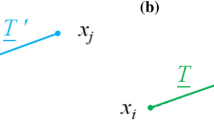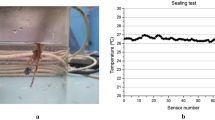Abstract
The aim of this study is to investigate the effect of frost damage on the strength and fracture properties of concrete formulated according to the standard NF EN 206-1 without air entraining agent. Prismatic 8 × 15 × 70 cm and cylindrical 16 × 32 cm specimens were subjected to various repeated freeze–thaw cycles according to the standard NF P 18-425 to induce different degrees of deterioration and the change in material properties was evaluated. Mechanical experiments were carried out on the specimens before and after their exposure to freezing–thawing cycles. The Young’s modulus was determined through compressive tests conducted on 16 × 32 cm cylindrical specimens. Flexure strength and fracture parameters were obtained according to RILEM recommendations from three point bending tests conducted on prenotched samples. Tensile strengths were obtained by split tensile tests conducted on 16 × 32 cylindrical specimens. The correlations between the number of freezing–thawing cycles and the mechanical properties reveal that the change in the tensile strength gives a better indication of degradation due to frost action. From force–crack mouth opening curves, F–CMOD, the intrinsic fracture properties were obtained using the cracked hinge model based on a power law strain-softening curve and an inverse analysis algorithm. It was observed that the fracture energy, \(G_{\text{F}}^{\text{RILEM}} ,\) calculated according to the RILEM recommendations decreases by increasing the ratio \(\frac{{a_{0} }}{H}\) (notch length/beam’s height). When \(\frac{{a_{0} }}{H}\) exceeds 0.45, \(G_{\text{F}}^{\text{RILEM}}\) reaches a value of 0.15 N/mm which is equal to the one obtained using the inverse analysis. Moreover, it has been established that the fracture energy, G F, and the critical crack opening displacement, w c, increase with freezing–thawing cycles.

















Similar content being viewed by others
References
Wardeh G, Mohamed MA, Ghorbel E (2011) Analysis of concrete internal deterioration due to frost action. J Build Phys 35(1):54–82
Ghorbel E, Wardeh G, Mohamed M (2010) Poroelastic analysis of the frost behaviour of self-compacting concrete. In: 6th International RILEM symposium on self-compacting concrete 4th North American conference on the design and use of SCC, Montreal, Canada, 2010
Zaman MS, Ridgway P, Ritchie AGB (1982) Prediction of deterioration of concrete due to freezing and thawing and to deicing chemical use. J Am Concr Inst 79(1):56–58
Powers TC, Helmuth RA (1953) Theory of volume changes in hardened Portland cement paste during freezing. In: Proceedings of the Highway Research Board, 1953
Scherer GW (1999) Crystallization in pores. Cem Concr Res 29(8):1347–1358
Powers TC (1949) The air requirement of frost-resistant concrete. In: Proceedings of the Highway Research Board, 1949
Wardeh G, Perrin B (2008) Numerical modelling of the behaviour of consolidated porous media exposed to frost action. Constr Build Mater 22(4):600–608
Marzouk H, Jiang D (1994) Effects of freezing and thawing on the tension properties of high-strength concrete. ACI Mater J 91(6):1–10
Penttala V, Al-Neshawy F (2002) Stress and strain state of concrete during freezing and thawing cycles. Cem Concr Res 35(4):1407–1420
Hillerborg A, Modéer M, Petersson P-E (1976) Analysis of crack formation and crack growth in concrete by means of fracture mechanics and finite elements. Cem Concr Res 6(6):773–781
Hillerborg A (1985) Results of three comparative test series for determining the fracture energy of concrete. Mater Struct 18:407–413
Hordijk DA (1991) Local approach to fatigue of concrete. Delft University of Technology, Delft, p 216
Ulfkjaer JP, Krenk S, Brincker R (1995) Analytical model for fictitious crack propagation in concrete beams. J Eng Mech 121(1):7–15
Wittmann F et al (1988) Fracture energy and strain softening of concrete as determined by means of compact tension specimens. Mater Struct 21(1):21–32
Wittmann FH, Mihashi H, Nomura N (1990) Size effect on fracture energy of concrete. Special issue fracture and damage of concrete and rock. Eng Fract Mech 35(1–3):107–115
Olesen JF (2001) Fictitious crack propagation in fiber-reinforced concrete beams. J Eng Mech 127(3):272–280
Roesler J et al (2007) Concrete fracture prediction using bilinear softening. Cem Concr Compos 29(4):300–312
Sundara Raja Iyengar KT, Raviraj S, Jayaram TN (2002) Analysis of crack propagation in strain-softening beams. Eng Fract Mech 69(6):761–778
50-FMC Draft Recommendation (1985) Determination of the fracture energy of mortar and concrete by means of three-point bend tests on notched beams. Mater Struct/Matéiaux Constr 18(4):287–290
Duan K, Hu X, Wittmann F (2003) Size effect on fracture resistance and fracture energy of concrete. Mater Struct 36(2):74–80
Setzer MJ et al (2001) CIF-Test-Capillary suction, internal damage and freeze thaw test. Mater Struct 34(9):515–525
Shah S (1990) Determination of fracture parameters of plain concrete using three-point bend tests. Mater Struct 23(6):457–460
Issa M et al (2000) Size effects in concrete fracture: Part I, experimental setup and observations. Int J Fract 102(1):1–24
Issa MA et al (2000) Size effects in concrete fracture—Part II: analysis of test results. Int J Fract 102(1):25–42
Kwon SH, Zhao Z, Shah SP (2008) Effect of specimen size on fracture energy and softening curve of concrete: Part II. Inverse analysis and softening curve. Cem Concr Res 38(8–9):1061–1069
Rosselló C, Elices M (2004) Fracture of model concrete: 1. Types of fracture and crack path. Cem Concr Res 34(8):1441–1450
Rosselló C, Elices M, Guinea GV (2006) Fracture of model concrete: 2. Fracture energy and characteristic length. Cem Concr Res 36(7):1345–1353
Yang Z, Weiss WJ, Olek J (2006) Water transport in concrete damaged by tensile loading and freeze–thaw cycling. J Mater Civ Eng 18(3):424–434
Hanjari KZ (2008) Material and bond properties of frost-damaged concrete. Department of Civil and Environmental Engineering Structural Engineering/Concrete Structures, Chalmers University of Technology. Report 2008:10, p 62
Menou A et al (2006) Residual fracture energy of cement paste, mortar and concrete subject to high temperature. Theor Appl Fract Mech 45(1):64–71
Prokopski G (1995) Fracture toughness of concretes at high temperature. J Mater Sci Springer Neth, 30(6):1609–1612
Østergaard L (2003) Early-age fracture mechanics and cracking of concrete. Experiments and modelling. Department of Civil Engineering, Technical University of Denmark, Lyngby, p 299
Skocek J, Stang H (2008) Inverse analysis of the wedge-splitting test. Eng Fract Mech 75(10):3173–3188
Tada H, Paris PC, Irwin GR (1985) The stress analysis of cracks handbook, 3rd Revised ed (2000). U.S. American Society of Mechanical Engineers, p 696
Author information
Authors and Affiliations
Corresponding author
Rights and permissions
About this article
Cite this article
Wardeh, G., Ghorbel, E. Prediction of fracture parameters and strain-softening behavior of concrete: effect of frost action. Mater Struct 48, 123–138 (2015). https://doi.org/10.1617/s11527-013-0172-8
Received:
Accepted:
Published:
Issue Date:
DOI: https://doi.org/10.1617/s11527-013-0172-8




